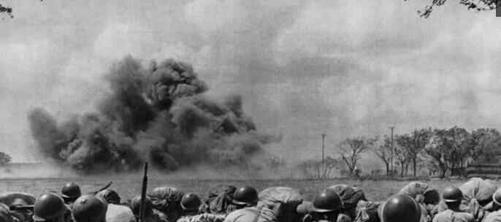Introduction: On July 7, 1937, the shocking "July 7 Incident" broke out, and Japan launched a comprehensive act of aggression against China. The following month, the Chinese and Japanese armies clashed in Shanghai over the "Hongqiao Airport Incident," and the Battle of Songhu broke out completely.
The mode of operation at the Battle of Songhu was different from the past, before the Chinese army took a defensive approach to the Japanese army's attack, but this time China took the initiative to attack, but the offensive was very fierce, and there was a momentum of fighting to the end.

At that time, the Nationalist government sent its main forces up, hoping to inflict heavy losses on the Japanese army when the Japanese army was unstable, and the troops participating in the war at that time included Zhang Zhizhong, Chen Cheng, Hu Zongnan's Central Army and other troops, and the generals who participated in the war in addition to the above three were Du Yuming, Huang Wei, Wang Yaowu, Sun Yuanliang, and so on.
At the same time, the Nationalist army also sent a newly established air force unit to bomb the Japanese army on the ground, and it can be said that this war basically used the Kuomintang's family foundation. In the face of such an offensive, although the Japanese army still had the superiority in weapons, at first it could only defend, but the Nationalist army could not break through the Japanese defense line. There are many reasons for this.
In the Battle of Songhu, where is the difference in strength between China and Japan? Japanese strength: rarely matched in the world
First of all, the Japanese fortifications were built very firmly, using reinforced concrete materials, and although the equipment of the Nationalist army was not bad, there was still a certain gap compared with the Japanese army, and it was impossible to break through the defense of the Japanese army.
Second, the cooperation between the army' army, navy and air force is too poor. Although the national army has a structure in terms of land, sea, and air, after all, it has just been established, and there is a lack of training in actual combat, let alone mutual cooperation, and its combat effectiveness has greatly declined.
Third, the quality of the Japanese army's individual soldiers is very high. At that time, Japan's logistics troops were plentiful, sending a lot of food to the front, and the soldiers fighting on the front line were nutritionally friendly, plus they were strictly trained in peacetime, accurate marksmanship, and also had a good bayonet fighting ability. Coupled with their high educational penetration rate, the entire unit has a high military quality and can perfectly carry out the orders of their superiors.
For the evaluation of the combat effectiveness of the Japanese army at that time, the British and Li Zongren both believed that the combat effectiveness of the other side was very strong, and the combat effectiveness of the Nationalist army was obviously relatively large compared with that of the Japanese army, and the soldiers of China and Japan were not on the same level.
The combat effectiveness of ordinary soldiers in the Nationalist army is relatively low, so the combat effectiveness in a war mainly comes from the command and sacrifice spirit of the middle and lower-ranking officers of the Nationalist army
In addition to this, there is a crucial point, the mobilization ability of the troops. The Japanese held their positions at the Battle of Songhu to buy enough time for their reinforcements, and seven divisions were then put into battle. Although it moved its troops late, with its superb mobilization ability, it quickly completed the assembly of 300,000 troops.
Compared with the mobilization ability of the Japanese army, the ability of the National Army to transport troops is far behind, the army can not be mobilized in large quantities at a time, can only be put into battle in a ladder, the organization is chaotic, the firepower cannot be used intensively, and the combat ability of the troops is once again reduced.
Therefore, although the Nationalist army claimed to have 700,000 troops put into battle, the number of people who really participated in the war effectively was far from reaching this number, so the number of Japanese troops participating in the Battle of Songhu was not less than that of the Nationalist army. In addition, the Japanese had carrier-based artillery moored on the Huangpu River to provide support.
When the Japanese bombers and carrier-based artillery continued to pour ammunition on the battlefield, the battle entered the daylight stage, the strength of a division was thrown into the battlefield, and within a few hours it disappeared, and the Songhu battlefield seemed to become a meat grinder, and countless soldiers died on this battlefield. The tragic degree of sacrifice of the armies of the Chinese nation this time is unique in the history of the Chinese nation.
Chiang Kai-shek's elite Central Army suffered heavy losses and did not recover for a long time. Although the troops suffered heavy losses, Chiang Kai-shek's transfer order was unexpectedly smooth. All the troops sent rushed to the battlefield and threw themselves into battle.
Although countless Nationalist troops rushed to the battlefield one after another and did not retreat from the battle, they still could not resist the offensive of the Japanese army, and were eventually forced to retreat, and the Battle of Songhu ended in failure. In this battle, the Chinese army suffered more than 300,000 casualties, but at the same time, the elite troops of the Japanese army also paid a heavy price of 90,000 casualties.
Summary: Although the Battle of Songhu was still defeated in the end, it crushed the Japanese army's quick battle and quick decision, and also bought time for other parts of China to make preparations for the anti-Japanese resistance, especially for the relocation of production machines and strategic materials in Shanghai and other places.